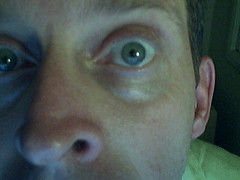I read this post from Diana some time ago. It provides an excellent background on the Rosenhan experiment that looked at "being sane in insane places" … and showed how the relationships between subject and object are far more fluid than we would like to believe. (One of the things I love about Diana’s blog and those of other clever planners, is that they expose the depth and breadth of their thought processes in bringing to light the new visions of old ideas.)
Diana’s post reminded me of a time in my life many years ago. I was fascinated by Romantic poetry and just happened to have a relationship crisis (isn’t it always the way?) that tipped me over the edge. I didn’t sleep for four days, wrote and read poetry incessantly and slowly but surely felt myself slipping into a form of madness. One night, suffering from exhaustion, I reached a point where I felt I could surrender — just simply stop fighting, and allow my mind to freewheel. For me, I could see there was a choice, but I wondered also how many other people had come to this point and not been able to hold back.
And one of the things that struck me was the seductiveness of this madness … and also its proximity. I had come to the brink of madness in only a matter of days!
The writings that I had accumulated in this time are powerful … and some of the best and most harrowing of any of my creative works. The journey had allowed me to tap into a very strong creative stream, but it also meant potential danger and sacrifice. Even now, writing this, I can feel my heart pounding … remembering the excitement and the fear. I think, in marketing, we call this "authenticity" … but very few of us are able to creatively take a "message" to this deep and scary place.
Ever since that time, I have maintained an interest in the crossing point of sanity and madness. And somehow, after reading Diana’s post, I found myself here at a site called "My Topsy Turvy Life" by Letha who works in a "medium secure forensic unit". The crossover in Letha’s life becomes palpable when her work comes home with her … and she has to change her shopping habits because a patient is released and moves into her neighbourhood. There are many interesting episodes … but I particularly love this post about a patient who knitted Letha a scarf using lots of interesting knots and colours especially selected for her.
And while we can poetically consider that the eyes are the gateways to the soul, simple acts of kindness for those less fortunate … or even simple acts of humanity, reach far deeper. It is one thing to look — but quite another to DO.

Hey Gavin,
Amazing post as always. I spent some time reading up on this experiment. Hadn’t heard of it.
Your writing makes me desire to be able to relate to this edge you experienced. Yet at the same time, I’m unsure if that is a good thing.
I have a writer friend who speaks of this bubbling up place that scares her because it throws everything into question… I think I might have a better concept of what she is speaking about now.
Fascinating. My uncle was schizophrenic and wrote volumes and volumes. I wanted to read them but my father told me that they were in code, which I found even more intriguing…
It is spooky stuff indeed … I will see if I can dig out some writing from my old notepads. Don’t remember if it was any good … but it certainly scared me a little.
The mind is such a mysterious frontier. So many billions of them on this planet, and all so changeable.
It seems like so many great writers have come to this edge and stepped back from it. One of the most memorable accounts of this I’ve read was “The Crack Up” by F. Scott Fitzgerald.
Gavin, as a writer, you’re in good company! 😉
Wonderful post Gavin. I used to work in a psychologist’s office and also in a treatment center for children with autism, plus I do have a bit of the artistic temperment that can sometimes skirt the edge of reality/alternate realtity, so psychology has always fascinated me.
Another thing to consider is that mental health practitioners have one of the highest rates of suicide (perhaps THE highest rate) of all the professions. It’s debated as to whether this is due to being constantly in contact with depressing, stressful patients, or whether it’s because people who are drawn to the psychological fields are naturally predisposed to depression and falling over the edge themselves. So another hurdle with determining who is sane or insane is that the mental practioners who are doing the diagnosing are perhaps not entirely mentally well themselves.
One of my favorite books about the blessing/curse of mental illness and creativity is “An Unquiet Mind” by Kay Redfield Jamison. Jamison is a psychiatrist/artist who also suffers from manic depression, and this book is her autobiograpy. She also has another wonderful book called “Touched with Fire: Manic Depressive Illness & the Artistic Temperment.”
Jamison says: “We are all, as Byron put it, differently organized. We each move within the restraints of our temperament and live up only partially to its possibilities.”
Thanks for sharing your experience with momentarily “touching the fire”, Gavin. I’ve been there too!
“It is one thing to look — but quite another to DO.”
Brilliant.
And great pics…I love how much “you” are on your blog these days.